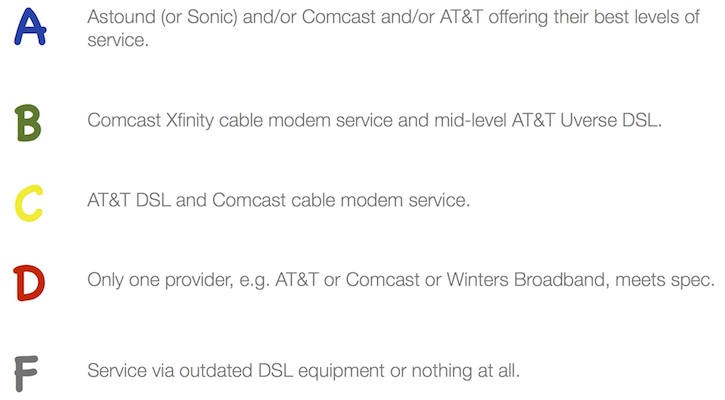
Examples of how the grading was done.
The grading system I developed to rate and compare the broadband infrastructure available to communities east of San Francisco – Alameda, Contra Costa and Solano Counties – focuses on primary, consumer wireline networks because those are the base upon which all service is built…
Even wireless systems must connect to wireline networks at some point, usually directly after the first “hop” from a subscriber. Consequently, the level of broadband connectivity in a region is primarily determined by the quality and extent of wireline facilities.
Although there is independent fiber available in limited areas – central business districts of large cities, for the most part – broadband companies that serve commercial customers generally rely on the core infrastructure built by the large, consumer-focused incumbents.
The grading criteria was first set by looking at service claims made by primary providers throughout California. Some – AT&T for example – file reasonably granular reports to the California Public Utilities Commission about what level of service to expect in a given census block. Those reports might tend to be on the optimistic side at times, but they give a fair picture of what’s available on the ground. For example, high download speeds – 10 Mbps or better – combined with substandard upload speeds (less than the CPUC’s 1.5 Mbps minimum) usually points to Uverse service installed on top of elderly copper plant.
Other carriers – most notoriously cable companies – simply claim to offer their highest level of service over their entire footprint in a community, unless they don’t offer broadband service at all. It’s not a complete fabrication: in theory the system might be able to deliver, say, 100 Mbps to any given home, but capacity issues and variance in the quality of the plant severely limit their ability to do so reliably or universally or to large numbers of customers. And cable companies tend to ignore business districts, where it’s harder to sell lucrative television packages.
Overall, the average Californian community has access to basic telco-grade DSL service and theoretically fast cable modem service. So a “C” means that there are at least two wireline, consumer grade broadband providers in a community (or census block – that’s the basic geographic unit used), one claiming 10 Mbps download and 6 Mbps upload speeds or better, and the others meeting the CPUC’s 6 Mbps down/1.5 Mbps up minimum. Upload speeds are an important element in the grading scheme, because providers will squeeze upstream bandwidth to eke out faster downloads on poor plant.
If two providers claim to hit the 10 up/6 down level or faster, the infrastructure was rated better than the statewide average – a “B” – and where the claims were superior – two providers advertising at least 25 down/6 up – an “A” was awarded.
If a community only has one wireline broadband provider but the speeds meet the CPUC’s minimum, then its infrastructure was judged barely passing: a “D”. If there was no wireline service at all or if what was available failed to meet the minimum, the infrastructure in a community (or census block) was given an “F” for failure.
Census block grades were averaged and weighted by population to generate a community’s report card. The full results are here.
Download the full version of the East Bay Broadband Report Card, including appendices (9.5 MB)
Download the East Bay Broadband Report Card only (2.1 MB)
Download the high resolution version of the East Bay Broadband Report Card, including appendices (81.1 MB)
